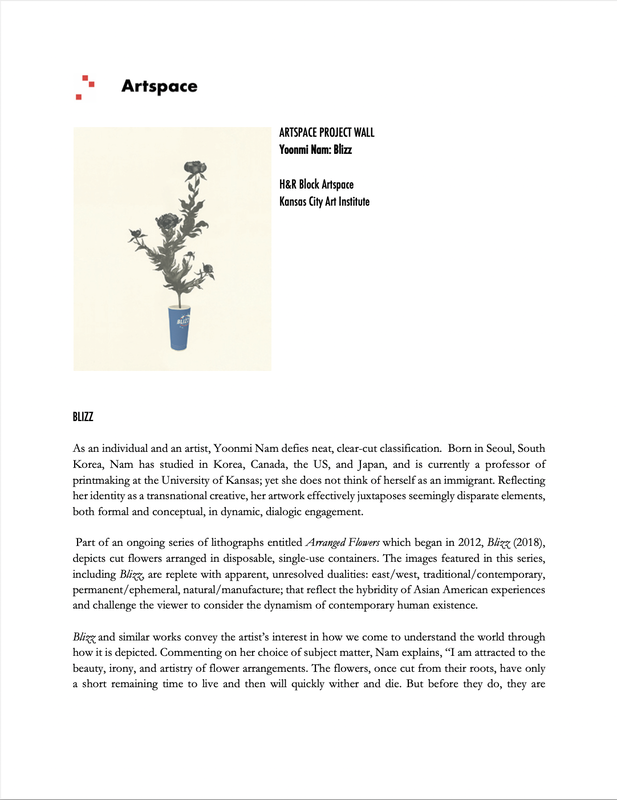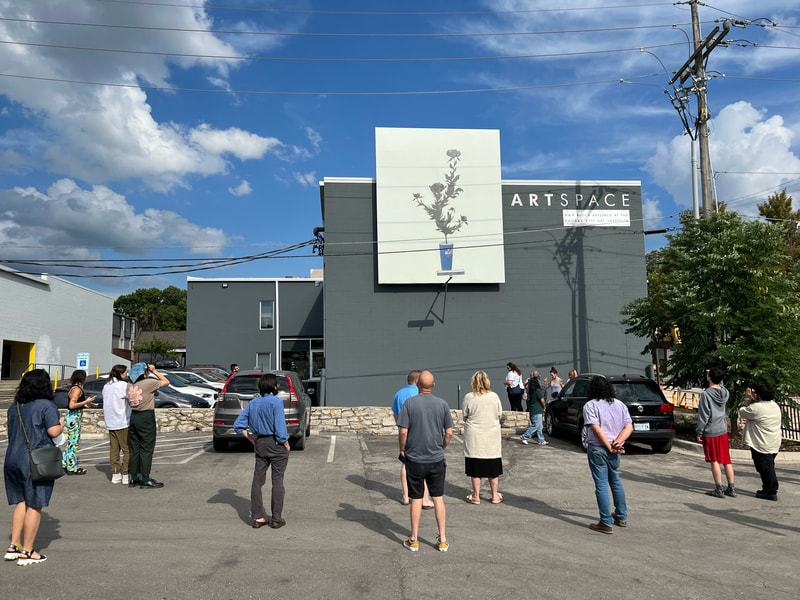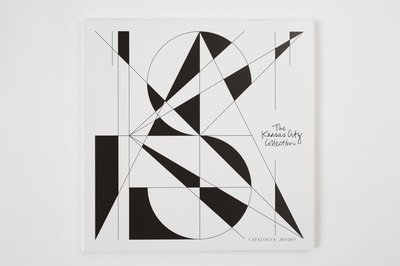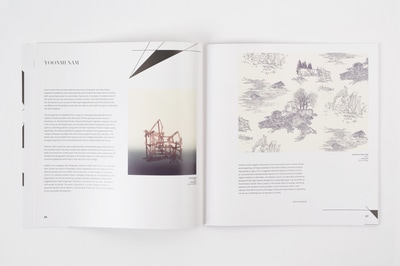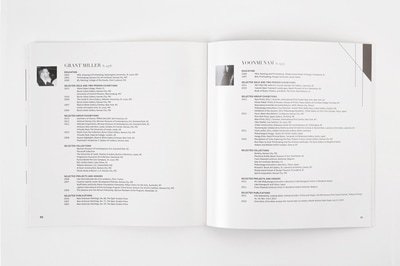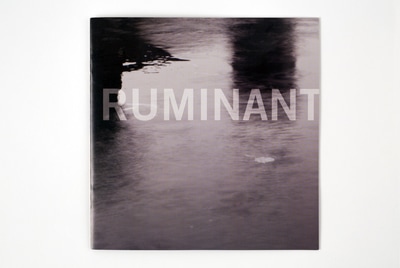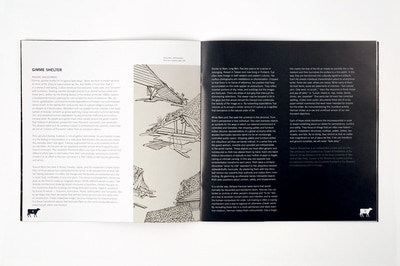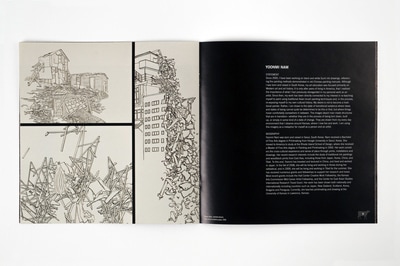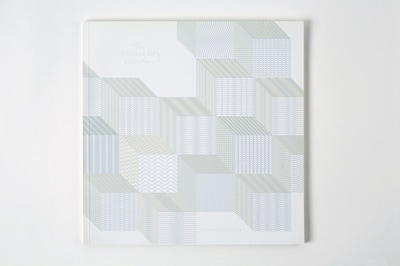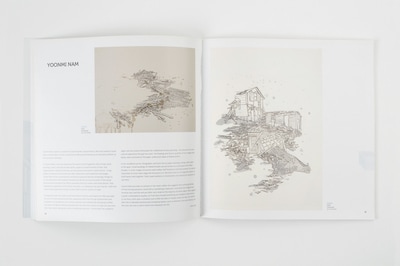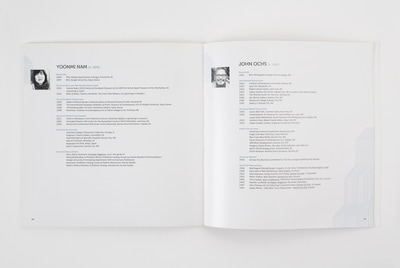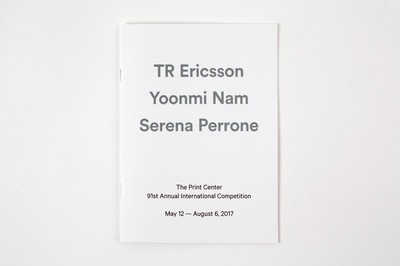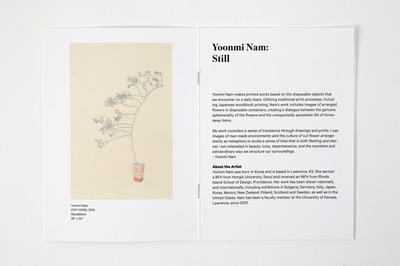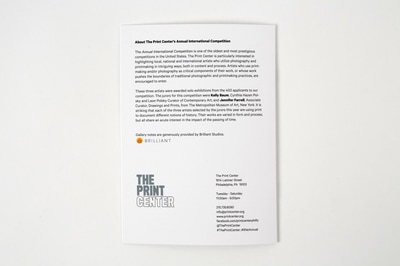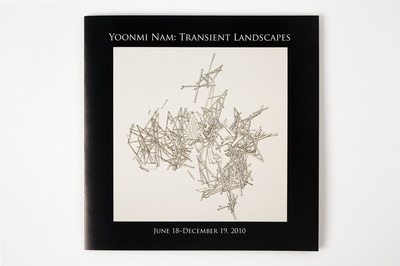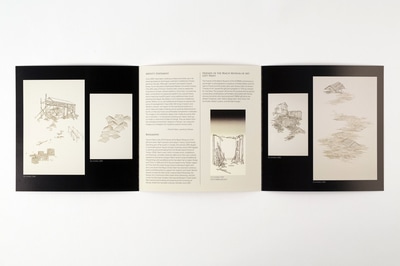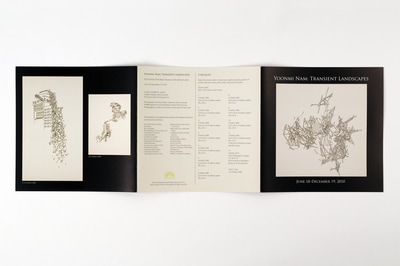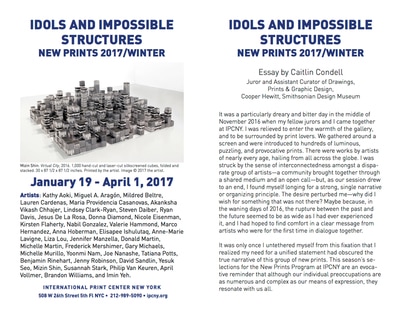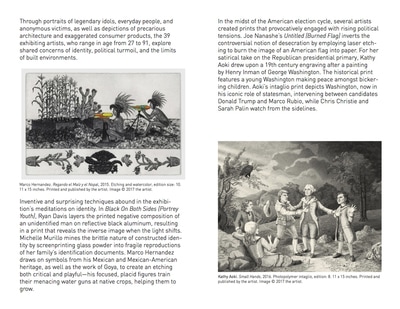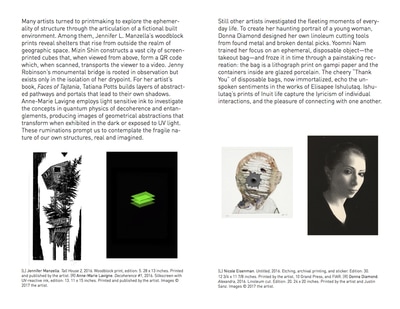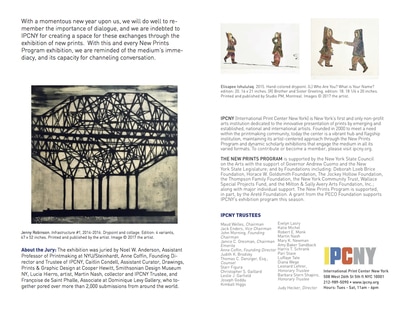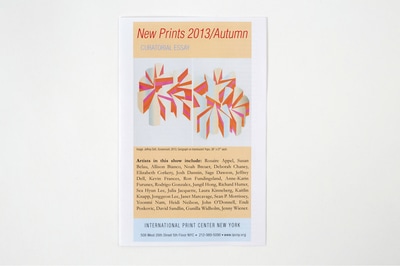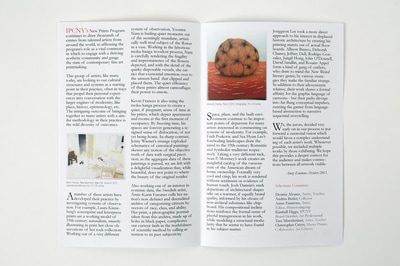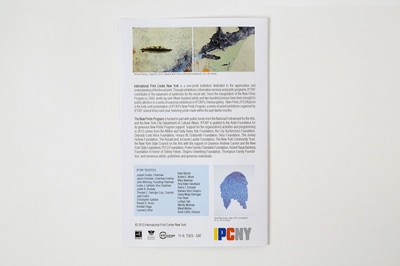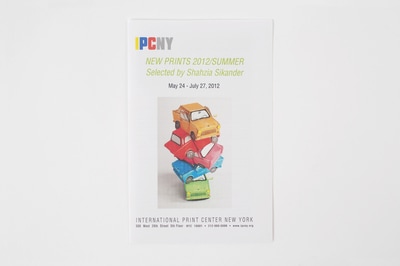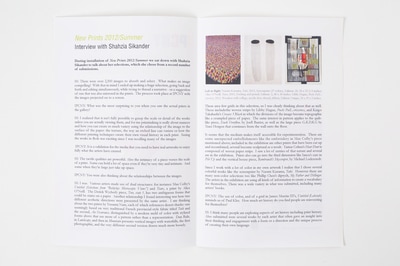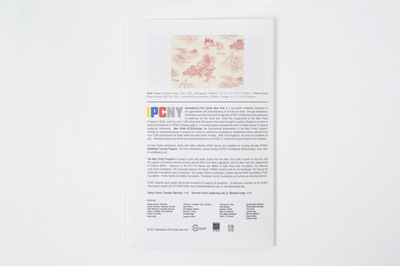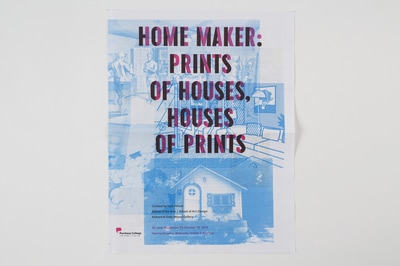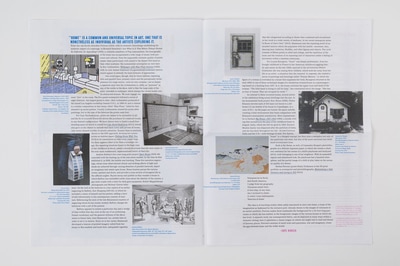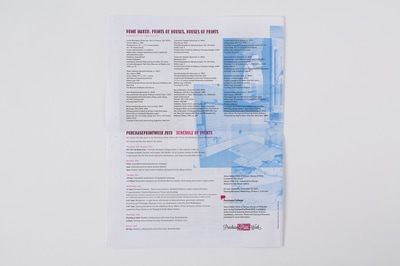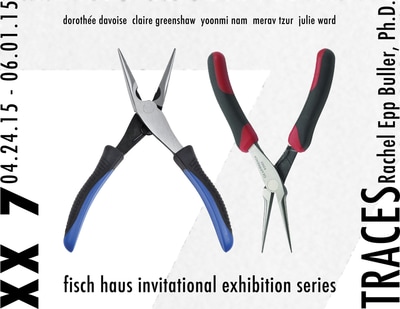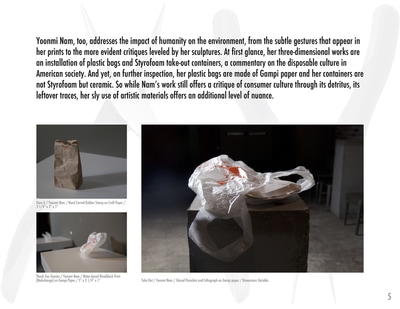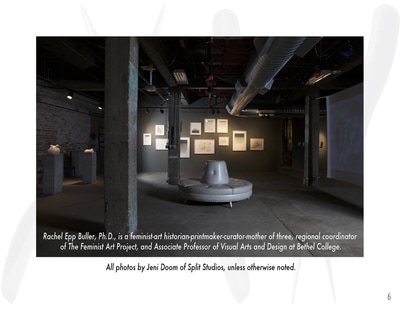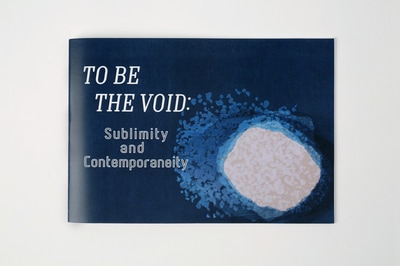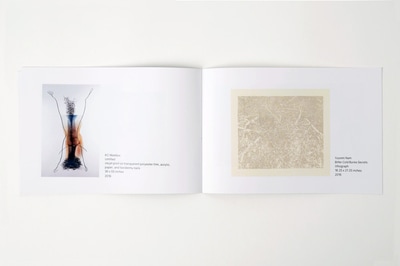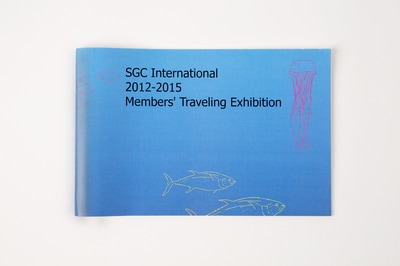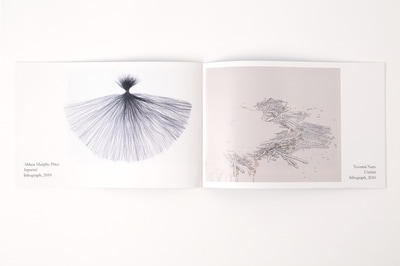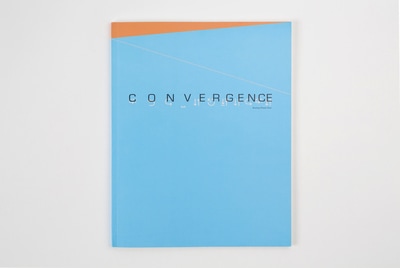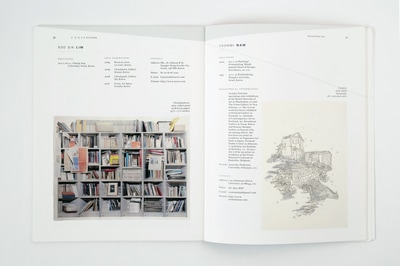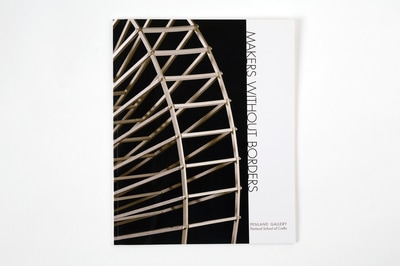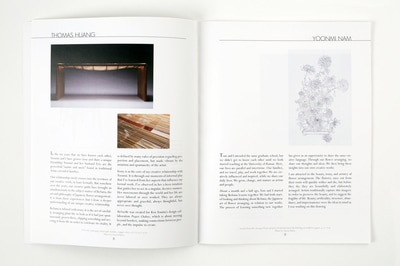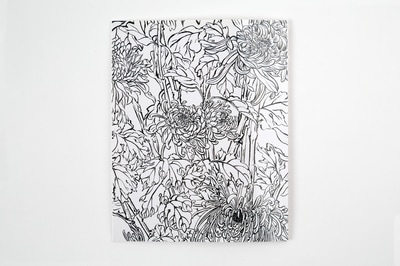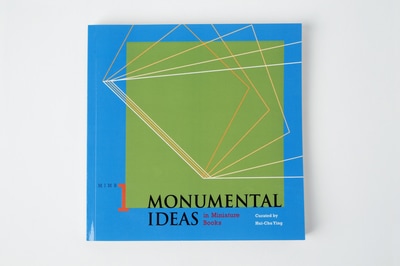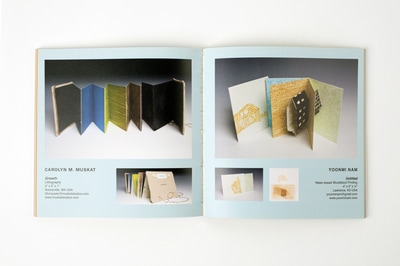+ ESSAYS & EXHIBITION CATALOGS
|
Blizz
H&R Block Artspace Project Wall (2022) - Kansas City, MO Essay by Eleanor Lim-Midyett Ph.D. |
|
The Kansas City Collection Catalog (2014-2015) - Kansas City, MO
Artist Yoonmi Nam produces delicate and precise lithographic and moku hanga(Japanese woodblock) prints that poetically point towards the impermanence of place, both real and perceived. As a printmaker, Nam works in multiples in multiple senses of the word; not only can she produce a number of prints of the same finished artwork, but she has built up an arsenal of individual image elements upon the surfaces of her woodblocks and lithography stones that are ready-to-print within any given composition the artist imagines.
The arrangement of repeated forms in space is a technique Nam gleamed from her studies of (and fascination with) the classic Chinese painting manual Jieziyuan Huazhuan(or, Mustard Seed Garden Manual of Painting). Originally compiled in the late 17th century by the Qing Dynasty, the Mustard Seed Garden Manual was (and still is) used as a teaching guide for young artists to learn standards of Eastern image making. Specifically, the Manual attempts to regulate the making of forms appearing within a larger landscape, including trees, hills, stones, people, houses, flora, and fauna. The artists’ job, as prescribed by the manual, was not to imagine new forms, but rather to arrange compositions from the perfected set of forms offered within the manual.
However, Nam resists the urge to depict pristine, finished landscapes composed from the accepted stuff of dynasty. Instead, Nam depicts architectural structures either in a state of construction or destruction that are much more dubious and mutable than the finished, pre-designated landscapes of the Garden Manual. In other words, all of the structures appearing within Nam's work will surely soon change.
Indeed, in her wallpaper-like lithograph, Lawrence in Blue Toile (2012), it is clear that Nam utilizes four distinct lithography stones repeatedly within one work, each of a distinct domestic structure either mid-construction, or mid-collapse. In Occurrence (2012), it is similarly unclear if Nam’s strangely composed set of wood-beams is the beginning or the end of something, a project started or abandoned. What kind of neighborhood is Nam imagining? The point is that we do not yet know. The point is that we get to decide. The point is possibility. It is anti-imagery to that of suburban sprawl and the generic, unendurable McMansion-style homes endemic of unsustainable development.
Similar concerns appear within Nam’s much more playful series of moku hanga prints depicting cut flowers doomed to fail within unlikely consumer products repurposed as vases. This is imagined, makeshift Ikebana. In Kitsune (2012), an oversized cherry blossom branch sprouts from the tiny enclave of a plastic yogurt container. In More Beer...For Instance (2013), an impossibly symmetrical bouquet of flat, folky flowers emerge from a disposable paper cup. As certain as these flowers will die, there is poetry in the human effort to arrange something beautiful with whatever means possible, if only momentarily. Nam’s work captures that effort in prints and images, linking the impermanent to something she can do, something she can reproduce, by hand.
- Danny Orendorff, Curator
The arrangement of repeated forms in space is a technique Nam gleamed from her studies of (and fascination with) the classic Chinese painting manual Jieziyuan Huazhuan(or, Mustard Seed Garden Manual of Painting). Originally compiled in the late 17th century by the Qing Dynasty, the Mustard Seed Garden Manual was (and still is) used as a teaching guide for young artists to learn standards of Eastern image making. Specifically, the Manual attempts to regulate the making of forms appearing within a larger landscape, including trees, hills, stones, people, houses, flora, and fauna. The artists’ job, as prescribed by the manual, was not to imagine new forms, but rather to arrange compositions from the perfected set of forms offered within the manual.
However, Nam resists the urge to depict pristine, finished landscapes composed from the accepted stuff of dynasty. Instead, Nam depicts architectural structures either in a state of construction or destruction that are much more dubious and mutable than the finished, pre-designated landscapes of the Garden Manual. In other words, all of the structures appearing within Nam's work will surely soon change.
Indeed, in her wallpaper-like lithograph, Lawrence in Blue Toile (2012), it is clear that Nam utilizes four distinct lithography stones repeatedly within one work, each of a distinct domestic structure either mid-construction, or mid-collapse. In Occurrence (2012), it is similarly unclear if Nam’s strangely composed set of wood-beams is the beginning or the end of something, a project started or abandoned. What kind of neighborhood is Nam imagining? The point is that we do not yet know. The point is that we get to decide. The point is possibility. It is anti-imagery to that of suburban sprawl and the generic, unendurable McMansion-style homes endemic of unsustainable development.
Similar concerns appear within Nam’s much more playful series of moku hanga prints depicting cut flowers doomed to fail within unlikely consumer products repurposed as vases. This is imagined, makeshift Ikebana. In Kitsune (2012), an oversized cherry blossom branch sprouts from the tiny enclave of a plastic yogurt container. In More Beer...For Instance (2013), an impossibly symmetrical bouquet of flat, folky flowers emerge from a disposable paper cup. As certain as these flowers will die, there is poetry in the human effort to arrange something beautiful with whatever means possible, if only momentarily. Nam’s work captures that effort in prints and images, linking the impermanent to something she can do, something she can reproduce, by hand.
- Danny Orendorff, Curator
Ruminant - Institute of Contemporary Art at Maine College of Art, Portland, ME (2008)
Yoonmi Nam has lived in Korea, Canada, Japan, and the midwestern United States. Each of these places has contributed to her sense of self yet each has at times left her feeling alienated. For Nam, the foreign and the familiar are enmeshed and she is never truly comfortable in any one place. The sense of estrangement informs her work as she tries to create an imaginary space "where different worlds co-exist." Her delicate architectural drawings depict structures in transition. Initially they give us the impression that the buildings are being destroyed by time, neglect, poverty or by forces of nature – tsunamis, hurricanes, floods, earthquakes, and tornadoes. But as we linger over them we realize that perhaps these are not ruins but rather sites of construction. These unpeopled images become metaphors for impermanence. It is these transitional spaces that fascinate Nam as she continuously attempts to orient herself within one location.
- Nadine Wasserman, Independent Curator and Freelance Art Critic
- Nadine Wasserman, Independent Curator and Freelance Art Critic
The Kansas City Collection Catalog (2010-2011) - Kansas City, MO
In Yoonmi Nam's work we experience the world in small fragments. Bits of trees, birds, buildings, water, and land all seem adrift, caught in a small moment of time. That fragmentation represents the way we may perceive the world in which we live. Living bodies and personal encounters are often replaced by web-based text and images. Actual face-to-face conversations and physical gestures become increasingly foreign to us. On some days small isolated moments are all that we may encounter of the actual physical world outside of our offices and away from our screens and smart phones. That fragmentary experience of the world sits easily-or uneasily as the case may be-with how Yoonmi Nam experiences living in a place that is not her country of origin.
A longing for both the mythical and real home of memory and experience often pervades the work of transnational artists who experience their lives through displacement and transience. Living between two cultures, perhaps never feeling fully belonging to either, may leave immigrants feeling alienated from not only their country of origin, but also from their new culture. Basing her work on traditional Asian art-Yoonmi Nam has studied in Japan and has a keen enthusiasm for traditional Chinese painting-she discerns her cross-cultural experience through her work. The floating and illusive qualities of her images that barely seem anchored to the paper underscore ideas of displacement.
In her woodblock prints, lithographs, and Sumi ink on paper drawings, things often seem to fall apart. Small buildings of indeterminate use are broken as wood peels off of their facades. In some images structures seem either half finished or half demolished. It is almost impossible to know what stage the structure is in. We only know it is a fragment; pieces of itself barely held together. Stairs lead nowhere, or wood planks are waiting for someone to use them.
Yoonmi Nam provides no answers in her work, rather she suggests the confusing feeling of time having passed or stood still or something in between. And while the images have minimal color and line and are often very small on the expanse of white paper, they suggest a quiet, contemplative quality, as if we have missed something we needed to see or know, or we have come upon a situation just a little too late, or maybe years too late. For Yoonmi Nam the in-between physical and conceptual places, such as between Asia and America, are the ones she lives in and in which she interprets her life.
- Dana Self, Independent Curator and Freelance Writer
A longing for both the mythical and real home of memory and experience often pervades the work of transnational artists who experience their lives through displacement and transience. Living between two cultures, perhaps never feeling fully belonging to either, may leave immigrants feeling alienated from not only their country of origin, but also from their new culture. Basing her work on traditional Asian art-Yoonmi Nam has studied in Japan and has a keen enthusiasm for traditional Chinese painting-she discerns her cross-cultural experience through her work. The floating and illusive qualities of her images that barely seem anchored to the paper underscore ideas of displacement.
In her woodblock prints, lithographs, and Sumi ink on paper drawings, things often seem to fall apart. Small buildings of indeterminate use are broken as wood peels off of their facades. In some images structures seem either half finished or half demolished. It is almost impossible to know what stage the structure is in. We only know it is a fragment; pieces of itself barely held together. Stairs lead nowhere, or wood planks are waiting for someone to use them.
Yoonmi Nam provides no answers in her work, rather she suggests the confusing feeling of time having passed or stood still or something in between. And while the images have minimal color and line and are often very small on the expanse of white paper, they suggest a quiet, contemplative quality, as if we have missed something we needed to see or know, or we have come upon a situation just a little too late, or maybe years too late. For Yoonmi Nam the in-between physical and conceptual places, such as between Asia and America, are the ones she lives in and in which she interprets her life.
- Dana Self, Independent Curator and Freelance Writer
Still - The Print Center, Philadelphia, PA (2017)
Yoonmi Nam makes printed works based on the disposable objects that we encounter on a daily basis. Utilizing traditional print processes, including Japanese woodblock printing, Nam's work includes images of arranged flowers in disposable containers, creating a dialogue between the genuine ephemerality of the flowers and the unexpectedly persistent life of throwaway items.
- John Caperton, The Jenson Bryan Curator
- John Caperton, The Jenson Bryan Curator
Yoonmi Nam: Transient Landscapes - Beach Museum of Art, Manhattan, KS (2010)
Since 2005, I have been working on black and white sumi ink drawings based on techniques outlined in traditional Chinese painting manuals. Although I was born and raised in South Korea, my art education emphasized Western art and art history. Only after years of living in America did I come to realize the importance of Asian cultural traditions. Since then, my work has been connected to re-exposing myself to my cultural history and re-teaching myself to paint using traditional Asian brush painting techniques. My desire is not to become a traditional painter. Rather, it is to use traditional techniques to express the sense of estrangement I have often felt living in Eastern and Western cultures. I am drawn to the transitional existence in which ideas and states of being cannot quite be determined to be this or that, but hover uncomfortably somewhere in between. The images in this exhibition depict man-made structures that are in transition - in the process of being torn down, built up, or simply in some kind of state of change. They are drawn from the everyday environment I observe in Kansas. I am using this imagery as a metaphor for myself as a person and an artist.
- Yoonmi Nam
- Yoonmi Nam
Idols and Impossible Structures: New Prints 2017/Winter - International Print Center New York, NY
Still other artists investigated the fleeting moments of everyday life. [...] Yoonmi Nam trained her focus on an ephemeral, disposable object - the takeout bag - and froze it in time through a painstaking recreation: the bag is a lithograph print on gampi paper and the containers inside are glazed porcelain. The cheery "Thank You" of disposable bags, now immortalized, [...]
- Caitlin Condell, Assistant Curator of Drawings, Prints & Graphic Design, Cooper Hewitt, Smithsonian Design Museum
- Caitlin Condell, Assistant Curator of Drawings, Prints & Graphic Design, Cooper Hewitt, Smithsonian Design Museum
New Prints 2013/Autumn - International Print Center New York, NY
Yoonmi Nam is building quiet moments out of the seemingly mundane, artistically well-trod subject of the flower in a vase. Working in the laborious moku hanga woodcut process, Nam is carefully rendering the fragility and impermanence of the flowers depicted, and with the detail of the quirky disposable vessels, she carries that existential attention over to the unseen hand that clipped and placed them. The quiet efficiency of these prints almost camouflages their power to emote.
- Amze Emmons, Artist
- Amze Emmons, Artist
New Prints 2012/Summer, Selected by Shahzia Sikander - International Print Center New York, NY
[...] Another relationship I found interesting was how two different aesthetic directions were presented by the same artist. I am thinking about the two prints by Yoonmi Nam, each of which references desert shacks: one seemingly based on very traditional French provincial-style fabric titled "Toile" and the second, "An Occurrence", distinguished by a modern meld of color with stylized forms above that use more of a pattern rather than a representation.
- Interview with Shahzia Sikander, Artist
- Interview with Shahzia Sikander, Artist
Home Maker: Prints of Houses, Houses of Prints - Richard & Dolly Maass Gallery, Purchase, NY (2013)
Yoonmi Nam is similarly drawn to the DIY approach, devising her screen prints on butcher paper "Taking Home With You (2012)" to be constructed as a take-away paper bags. On them appears what is for Nam a nostalgic image: the repeating windows found in the high rises of her childhood in Seoul, pastel-colored structures that are now scarce in the ever more modernized, depersonalized fabric of that city.
- Faye Hirsch, Editor & Critic
- Faye Hirsch, Editor & Critic
|
Traces
-Fisch Haus, Wichita, KS (2015) |
|
Yoonmi Nam, too, addresses the impact of humanity on the environment, from the subtle gestures that appear in her prints to the more evident critiques leveled by her sculptures. At first glance, her three-dimensional works are an installation of plastic bags and Styrofoam take-out containers, a commentary on the disposable culture in American society. And yet, on further inspection, her plastic bags are made of Gampi paper and her containers are not Styrofoam but ceramic. So while Nam's work still offers a critique of consumer culture through its detritus, its leftover traces, her sly use of artistic materials offers an additional level of nuance.
- Rachel Epp Buller, Ph.D., Feminist-art Historian & Curator
- Rachel Epp Buller, Ph.D., Feminist-art Historian & Curator
|
To Be The Void: Sublimity and Contemporaneity
- Krakow International Cultural Center, Poland (2016) |
|
|
SGC International Members' Traveling Exhibition 2012-2015
|
|
|
Convergence: Korean Prints Now
- Houston & Lubbock, TX (2010) |
|
|
Makers Without Borders
- Penland Gallery, NC (2009) |
|
|
Monumental Ideas in Miniature Books - Traveling Exhibition (2009-2012)
|
|
